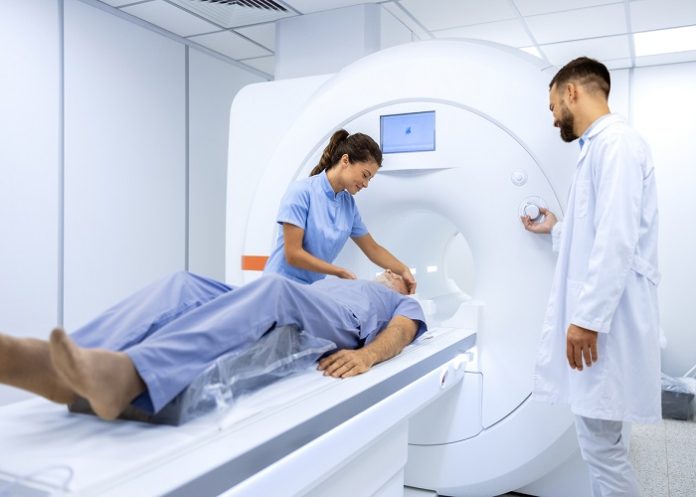A group of American physicians has warned that CT scans commonly taken to help detect injury and disease may be accompanied by an alarming risk – they might account for 5% of all cancer cases each year.
Radiation from imaging could lead to deadly lung, breast and other cancers, the doctors at the University of California-San Francisco have suggested. In 2023 alone, between three and four times more cancers were predicted to result from CTs performed than in previous assessments.
The researchers also found that infants under 12-months-old were 10 times as likely to get cancer than others included in their research, reports The Independent.
“Given the large volume of CT use in the United States, many cancers could occur in the future if current practices don’t change,” Dr Rebecca Smith-Bindman, a professor of epidemiology and biostatistics, warned.
Smith-Bindman was the lead author of the National Institutes of Health-funded research, published this month in JAMA Internal Medicine.
While the number of annual CT scans, or computed tomography scans, has surged by 30% in the US since 2007, it has long been known that the non-invasive X-ray procedure carries a higher threat of cancer. Scans expose patients to ionising radiation that can increase the risk even with a low dose.
Although everyone is exposed to ionising radiation every day from the natural environment, added exposures can raise the possibility of developing cancer later in life. Furthermore, CT scans usually require more exposure to radiation than common X-rays because they use a series of images, said health officials.
To understand more about this relationship, the study’s authors estimated the total number of cancers associated with radiation exposure in relation to the numbers and types of CTs performed in 2023.
They looked at 93m exams from 61.5m patients in the US, with the majority from adults aged between 60 and 69. Of those exams, people between 50 and 59 had the highest number of projected cancers, including lung, colon, leukaemia, bladder, and breast cancer.
Notably, CTs are used in lung and colon cancer screening.
The largest number of cancers in adults came from CTs of the abdomen and pelvis, in children, from CTs of the head.
“Our estimates put CT on par with other significant risk factors, like alcohol consumption and excess body weight,” said Smith-Bindman. “Reducing the number of scans and reducing doses per scan would save lives.”
The authors warned that some CT scans are overused, including those for upper respiratory infections or for headaches without symptoms.
“Most patients will not develop cancer from a CT scan,” Smith-Bindman said. “But if you’re not getting any benefit, then even a small risk is unacceptable.”
Study details
Projected Lifetime Cancer Risks From Current Computed Tomography Imaging
Rebecca Smith-Bindman, Philip W. Chu, Hana Azman Firdaus, et al.
Published in JAMA Internal Medicine on 14 April 2025
Abstract
Importance
Approximately 93m computed tomography (CT) examinations are performed on 62 million patients annually in the United States, and ionising radiation from CT is a known carcinogen.
Objective
To project the number of future lifetime cancers in the US population associated with CT imaging in 2023.
Design, Setting, and Participants
This risk model used a multicentre sample of CT examinations prospectively assembled between January 2018 and December 2020 from the University of California San Francisco International CT Dose Registry. Data analysis was conducted from October 2023 to October 2024.
Main Outcomes and Measures
Distributions of CT examinations and associated organ-specific radiation doses were estimated by patient age, sex, and CT category and scaled to the US population based on the number of examinations in 2023, quantified by the IMV national survey. Lifetime radiation-induced cancer incidence and 90% uncertainty limits (UL) were estimated by age, sex, and CT category using National Cancer Institute software based on the National Research Council’s Biological Effects of Ionising Radiation VII models and projected to the US population using scaled examination counts.
Results
An estimated 61 510 000 patients underwent 93 000 000 CT examinations in 2023, including 2 570 000 (4.2%) children, 58 940 000 (95.8%) adults, 32 600 000 (53.0%) female patients, and 28 910 000 (47.0%) male patients. Approximately 103 000 (90% UL, 96 400-109 500) radiation-induced cancers were projected to result from these examinations. Estimated radiation-induced cancer risks were higher in children and adolescents, yet higher CT utilisation in adults accounted for most (93 000; 90% UL, 86 900-99 600 [91%]) radiation-induced cancers. The most common cancers were lung cancer (22 400 cases; 90% UL, 20 200-25 000 cases), colon cancer (8700 cases; 90% UL, 7800-9700 cases), leukaemia (7900 cases; 90% UL, 6700-9500 cases), and bladder cancer (7100 cases, 90% UL, 6000-8500 cases) overall, while in female patients, breast was second most common (5700 cases; 90% UL, 5000-6500 cases). The largest number of cancers was projected to result from abdomen and pelvis CT in adults, reflecting 37 500 of 103 000 cancers (37%) and 30 million of 93 million CT examinations (32%), followed by chest CT (21 500 cancers [21%]; 20 million examinations [21%]). Estimates remained large over a variety of sensitivity analyses, which resulted in a range of 80 000 to 127 000 projected cancers across analyses.
Conclusions and Relevance
This study found that at current utilisation and radiation dose levels, CT examinations in 2023 were projected to result in approximately 103 000 future cancers over the course of the lifetime of exposed patients. If current practices persist, CT-associated cancer could eventually account for 5% of all new cancer diagnoses annually.
See more from MedicalBrief archives:
Concern over diagnostic low-dose radiation exposure challenged – study
The retreat of radiation, mainstay of cancer treatment
Dental X-ray lead aprons not needed, say experts

